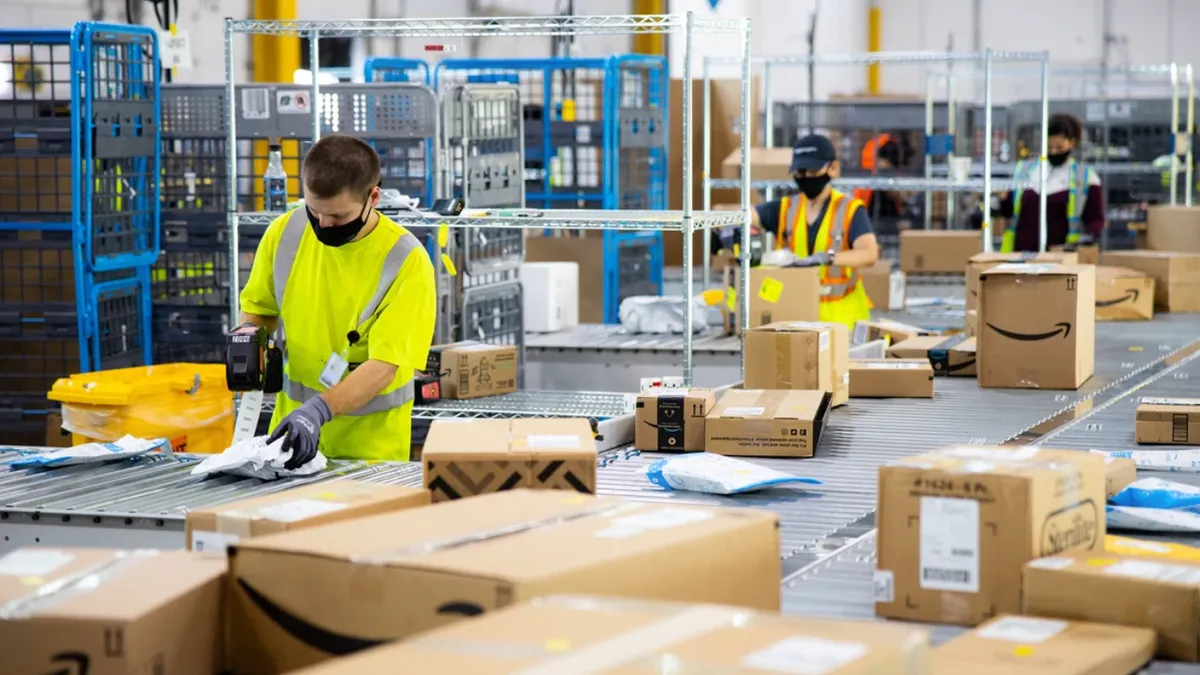Amazon aims to mitigate the cost of placing products near customers while keeping inventories in check under new fees for third-party sellers using its fulfillment services.
The company expects sellers to see an average fee increase of $0.15 per unit sold after the changes take effect next year. The charges come after Amazon completed an overhaul of its fulfillment network earlier this year, shifting to a regional model that has boosted delivery speeds while achieving higher in-stock levels.
"These investments result in higher customer satisfaction and more sales for you," Amazon said in an announcement to sellers on Tuesday. "As we look to 2024, we will implement a set of fee changes that continue to provide you with a great value and allow us to partner together to offer customers amazing service while reducing our collective costs to do so."
On March 1, Amazon will implement a fee it says reflects the cost of sending products into fulfillment network facilities closest to shoppers. The "inbound placement service fee," the result of Amazon separating inbound and outbound fulfillment charges, averages $0.27 per unit for standard-sized products and $1.58 per unit for larger items.
The Amazon facility the item is shipped to will impact the cost, with the company noting that shipments going to the Western U.S. will generally be higher. The fee will be charged 45 days after the product is received.
"Amazon pays more money if the inventory isn't close to the shopper," Scott Needham, founder of SmartScout, which offers software to Amazon sellers, said in a LinkedIn post about the charges. "They want you to be a part of their optimization."
Amazon's inbound placement service fee for inventory sent to a single location
| Size | Fee range per unit |
|---|---|
| Small standard | $0.21 to $0.30 |
| Large standard | $0.23 to $0.68 |
| Large bulky | $2.16 to $6.00 |
Source: Amazon. Effective March 1, 2024. Fee varies based on weight and inbound location.
Amazon will also add a fee starting April 1 in instances of low seller inventory levels, as insufficient stock makes it harder to place products closer to customers and increases transportation costs, the company said. Sellers can avoid this fee for standard-sized products by maintaining more than 28 days of inventory relative to historical demand.
"For some sellers this is gonna be killer," Needham said. "Sometimes inventory levels are controlled by their suppliers."
Amazon's low inventory level fee, based on days of supply relative to historical demand
| Size | 0-14 days | 14-21 days | 21-28 days |
|---|---|---|---|
| Small standard | $0.89 | $0.63 | $0.32 |
| Large standard (Up to 3 lbs.) | $0.97 | $0.70 | $0.36 |
| Large standard (3 lbs. to 20 lbs.) | $1.11 | $0.87 | $0.47 |
Source: Amazon. Effective April 1, 2024. Fee is added for all shipped units of eligible products.
Despite the new fees, Amazon said it expects some sellers will see a decrease in average fees per unit sold. New price reductions the company is rolling out to sellers include:
- A discount of up to 100% on the inbound placement service fee for inventory sent to multiple inbound locations
- A decrease to Fulfillment by Amazon fulfillment fee rates for standard products by $0.20 per unit and larger items by $0.61 per unit. Those changes will take effect April 15, the same date inbound placement fees will first be charged
- A fulfillment fee reduction for eligible products in its Ships in Product Packaging program. The discounts range from $0.04 to $1.32 depending on item size and weight and will apply starting Feb. 5
- During the "non-peak" period of January through September, monthly storage fees for standard-size products will drop from an average of $0.87 per cubic foot to $0.78 per cubic foot















